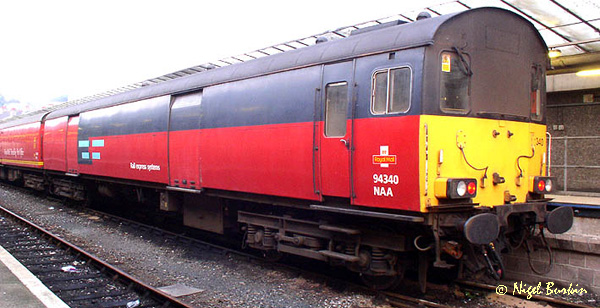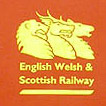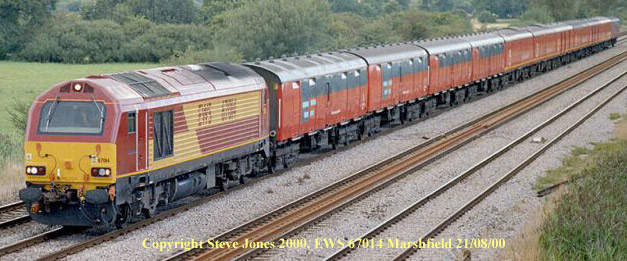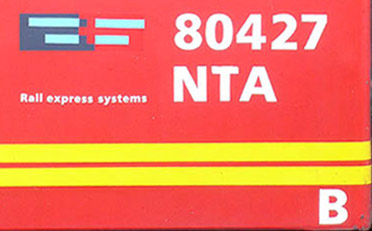 |
Here we look at the Rail Express Systems (RES) and the Non-Passenger Carrying Coaching Stock (NPCCS) and Total Operations Processing System (TOPS). |
Here is a brief history of some of the changes in British Rail in the lead up to privatisation and beyond...
Freight
In 1991 it was decided to abandon the conveyance of freight in less than trainloads, except for containers carried between a few intermodal terminals. Thus TrainLoad Freight (TLF) was made up of three sectors:
|
In 1994, TLF TrainLoad Freight was split into three separate divisions prior to privatisation:
|
In 1991, the parcel carrying operations of British Rail became Rail Express Systems (RES). It is thought that the predominantly red livery was chosen because its major customer was the Post Office.
Rail Express Systems
Rail Express Systems (RES) was formed in 1991, using the blue/grey and red livery as in the photo above. RES was responsible for running the Royal Mail's TPOs, some retained steam engines as well as the Royal Train.
In December 1995, as part of the privatisation sell-off, RES was bought by an international consortium which was lead by Wisconsin Central Transportation. In February 1996, Transrail, Loadhaul and Mainline were also purchased and the thus the amalgamated divisions (and RES) began trading as the English, Welsh & Scottish Railway (EWS).
From about 1997 the new EWS maroon and yellow livery began to be introduced for its locomotives, while coaches remained in the RES colours.
In January 2001 the Canadian National Railway Company (CN) and Wisconsin Central Transportation Corp (WCTC) merged, but EWS remains as a UK subsidiary.
Class 47 Diesels
Anorak Fact: The newly painted red Rail Express Systems' Class 47 locos had acquired a reputation for being unreliable. To counter this, new generic loco names were devised, such as Resilient, Resourceful, Response, Resolute etc. All including the letters RES.
|
|
|
"The RES Class 47/7 locomotives (47721 onwards) were converted from the standard 47/4 and 47/8 locomotives when in Rail Express Systems (RES) ownership c.1994. The conversion works included a number of reliability modifications, fitting RCH jumper cables (enabling the locomotives to communicate with the PCV driving trailers while reversing into the PRDC mail centre at Willesden) and also the fitting of long range fuel tanks."
Other named locos, such as 47476 Night Mail, confirmed the work of these Class 47 diesels.
EWS (English Welsh & Scottish Railway)
 |
The successor to RES was the English Welsh & Scottish Railway, which trades as simply EWS... |
 |
From about 1997 the new EWS maroon and yellow livery began to be introduced for its locomotives, while coaches remained in the RES colours. |
EWS found that the aging fleet of Class 47 diesels were not suitable for their improved operations of RES mail carrying duties, so new locos were ordered from GM (General Motors) who in turn contracted Alstrom to design and supply what was to be the new Class 67.
Imported from Valencia, Spain, the Class 67s had to undergo strict testing and some modifications before Railtrack allowed them to operate in the UK. However, by July 2001, the first diesel 67003 had been tested up 125 mph, proving that the new design was up to the job.
Total Operational Processing System (TOPS)
TOPS was introduced by British Rail in 1972 to improve the management and control of its rolling stock.
Vehicle type list:
"Every vehicle that is authorised for operation on the Railtrack network is allocated a TOPS carknd code. This comprises of a three letter code which is normally displayed on the vehicle, plus an additional fourth letter code called the aarkind which is not displayed but further defines the vehicle type on official records."
Eg. NAA is a Propelling Control Vehicle.
Non-Passenger Carrying Coaching Stock (NPCCS)
Mail Train Coaches
Liveries
In the early days, mail train coaches were painted in the liveries of the operating companies. Thus those for use on the Southern Railway (SR) were finished in green.
All coaches could be identified by the 'Royal Mail' lettering.
Following nationalisation and the formation of British Railways in 1948, the new Mark 1 mail coaches were generally (with some exceptions) painted Post Office red, lined in black and yellow.
British Railways became British Rail (BR) in 1965 and by about 1970 even the mail coaches were repainted in the new blue/grey livery. It is suggested that Great Train Robbery (1963) lead to the need for trains carrying mail to be less obvious as to their contents. Prior to 1963, bullion was also carried on mail trains.
In 1986 as part of the filming for 'Night Mail II', TPO stock was again painted red, but with the new signage 'Royal Mail Letters'.
From about 1990, white lettering on postal stock coaches declared 'Royal Mail Travelling Post Office', being the first time that the usage was fully identified.
BR Parcels stock was painted blue/grey and red as part of the Rail Express System circa 1991. This gives the mix of red coaches of a typical mail train, as in the EWS photo above.
NPCCS Codes
Mark 1 NPCCS Serial numbers:
80xxx for mail vans
94xxx for parcel vans
|
|
|
These consist of 4 characters - only the first three are marked on the rolling stock.
|
|
|
|
 |
First two letters are TOPS code, and the third defines the brake type. |
| Original Code | Description | TOPS Code |
The 'Super BGs and GUVs' were conversions to Royal Mail specs. to enable the vans to carry 'York' containers. The modifications also included the fitting of high security roller shutter doors, steel non-slip floors and a segregated shunter's compartment. |
| BG | Gangwayed, full Brakes | ||
| Super BG | Upgraded Gangwayed, full Brakes | NBA | |
| GUV | General Utility Vehicles | ||
| Super GUV | Upgraded General Utility Vehicles | NKA | |
| PCV | Propelling Control Vehicles | NAA | |
| POS | Post Office Sorter | NSX | |
| POT | Post Office Tender | NTA | |
| BPOT | Brake Post Office Stowage Van | ||
| POT (B) | Post Office Tender (Brake) |
Class 67 Photo Gallery
All logos and trade marks are the property of their respective owners and are used on the Light Straw site(s) for review only. Students and researchers are recommended to make their own independent enquiries as to the accuracy of the information contained therein.